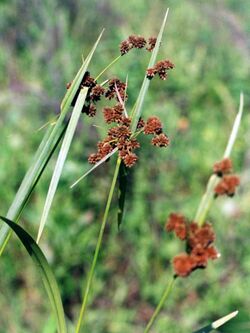Biology:Scirpus atrovirens
From HandWiki
Short description: Species of grass-like plant
| Scirpus atrovirens | |
|---|---|

| |
| At Nahant Marsh in Scott County, Iowa | |
| Scientific classification | |
| Kingdom: | Plantae |
| Clade: | Tracheophytes |
| Clade: | Angiosperms |
| Clade: | Monocots |
| Clade: | Commelinids |
| Order: | Poales |
| Family: | Cyperaceae |
| Genus: | Scirpus |
| Species: | S. atrovirens
|
| Binomial name | |
| Scirpus atrovirens | |
Scirpus atrovirens, known as dark-green bulrush, is a perennial sedge native to wetlands of eastern Canada and the United States.[1][2][3][4] It is sometimes called dark green bulsedge,[5] black bulrush,[4] or green bulrush.[4]
Scirpus atrovirens grows in a wide variety of wetland habitats, typically in sunny areas rather than shady. It can be found in wet meadows and shrubby thickets, openings in swamps, marshes, shorelines, as well as roadside ditches.[2] The plant can grow up to five feet tall, and thrives in hardiness zones 3–9.[6]
It is closely related to Scirpus hattorianus and Scirpus georgianus, with mature fruits necessary for accurate identification.[2]
References
- ↑ "Scirpus atrovirens Willd.". Royal Botanic Gardens, Kew. https://powo.science.kew.org/taxon/urn:lsid:ipni.org:names:313222-1. Retrieved 20 January 2020.
- ↑ 2.0 2.1 2.2 Reznicek, A. A.; Voss, E. G.; Walters, B. S., eds (February 2011). "Scirpus atrovirens". University of Michigan Herbarium. https://michiganflora.net/species.aspx?id=1152.
- ↑ Wilhelm, Gerould; Rericha, Laura (2017). Flora of the Chicago Region: A Floristic and Ecological Synthesis. Indiana Academy of Sciences.
- ↑ 4.0 4.1 4.2 "Scirpus atrovirens Willd.". 2010. https://data.canadensys.net/vascan/taxon/5327. Retrieved 20 January 2020.
- ↑ Mohlenbrock, Robert H. (2005). Cyperaceae: Sedges. Southern Illinois University Press. ISBN 9780809332274.
- ↑ "Scirpus atrovirens - Plant Finder". http://www.missouribotanicalgarden.org/PlantFinder/PlantFinderDetails.aspx?taxonid=279727.
Wikidata ☰ Q15624270 entry
 |

